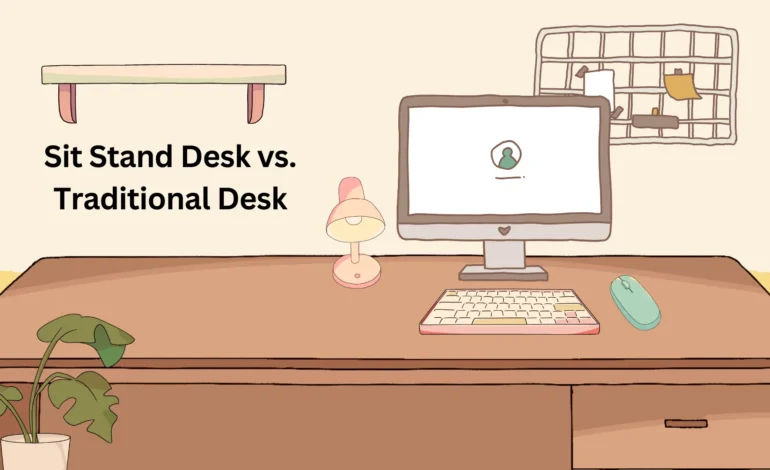
Sit Stand Desk vs. Traditional Desk
Choosing the right desk can have a significant impact on your productivity, comfort, and long-term health. With more options available than ever, the decision often comes down to a sit stand desk versus a traditional desk. Both have their benefits and drawbacks, so understanding their differences is essential to selecting the best fit for your workspace. In this article, we’ll explore the key features, advantages, and considerations for each type of desk to help you make an informed decision.
Table of Contents
1. Understanding the Basics
- Sit Stand Desk: Also known as a height-adjustable or standing desk, this type of desk allows users to alternate between sitting and standing throughout the day. It’s designed to offer flexibility and promote better posture and health by varying positions.
- Traditional Desk: A fixed-height desk that provides a consistent sitting position. While traditional desks come in various styles and sizes, they don’t offer the versatility of adjustable height settings.
2. Health Benefits and Posture Support
One of the most compelling reasons to choose a sit stand desk is the range of health benefits it offers. Prolonged sitting has been linked to issues such as back pain, neck strain, and even cardiovascular problems. A sit stand desk encourages users to change positions, which can alleviate these problems and improve overall posture.
In contrast, a traditional desk may not provide the same health advantages unless paired with ergonomic accessories like an adjustable chair or monitor stand. Without the option to switch between sitting and standing, users may develop habits that contribute to musculoskeletal discomfort over time.
3. Energy and Productivity
Research has shown that standing desks can lead to improved energy levels and productivity. Standing for parts of the day helps maintain alertness, reduces fatigue, and promotes better circulation. Users of sit stand desks often report feeling more engaged and less prone to the mid-afternoon slump compared to those who work exclusively at traditional desks.
Traditional desks, on the other hand, might be suitable for tasks that require intense concentration and stability, such as detailed writing or design work. However, for general office tasks, a sit stand desk can provide a more dynamic and energizing work environment.
4. Customization and Flexibility
One of the major advantages of a sit stand desk is its adjustability. Most models come with electronic or manual mechanisms that allow you to change the height with ease. This flexibility can be beneficial for shared workspaces or for individuals who prefer to mix up their routine throughout the day.
Traditional desks lack this adaptability and are best suited for users who prefer a stable, seated workspace. However, they can be customized with add-ons such as monitor arms or keyboard trays to enhance comfort.
5. Cost Considerations
Budget is often a deciding factor when choosing between a sit stand desk and a traditional desk. Sit stand desks tend to be more expensive due to their adjustable mechanisms and additional features. The investment, however, can pay off in the form of long-term health benefits and increased productivity.
Traditional desks are generally more affordable and come in a wider range of budget-friendly options. If cost is a primary concern, a traditional desk paired with ergonomic accessories might be a more feasible solution.
6. Ease of Use and Setup
Sit stand desks, particularly electric models, are relatively easy to use and can be adjusted at the touch of a button. Manual versions may require some physical effort to change the height but still offer the benefit of adjustability. Setup for these desks might involve more complexity due to the mechanical components.
Traditional desks are simpler in design and easier to set up. They often require minimal assembly and can be used right away. If simplicity and quick installation are important to you, a traditional desk may be the more appealing option.
7. Space and Layout
The type of desk you choose can also depend on the space you have available. Sit stand desks may take up more room due to their adjustable components and the need for clearance when transitioning between positions. Ensure that your workspace can accommodate these changes without causing obstruction.
Traditional desks typically have a smaller footprint and can be more suitable for tight or shared spaces. They can fit easily into home offices or smaller office cubicles where space is limited.
Conclusion
Choosing between a sit stand desk and a traditional desk comes down to personal preferences, health goals, and work habits. If you prioritize health benefits, flexibility, and the ability to adjust your working position throughout the day, a sit stand desk may be the ideal choice. However, if you’re looking for simplicity, cost-effectiveness, and a stable work setup, a traditional desk could meet your needs.
Ultimately, evaluating your work style, budget, and available space will guide you to the best decision. For those who spend long hours at their desks, investing in a solution that supports health and comfort can make a significant difference in your daily routine and overall well-being.





